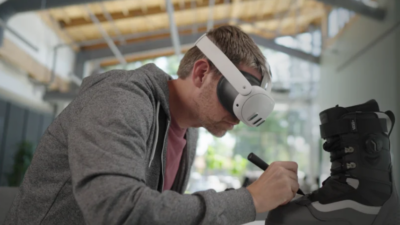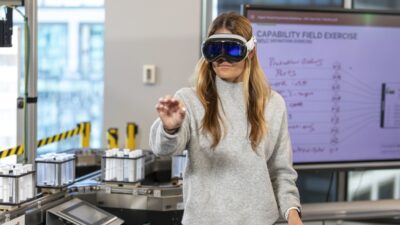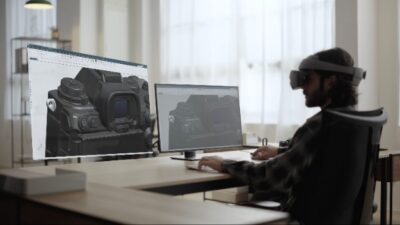Virtual and mixed reality devices aim for high-fidelity to bridge the gap between real and virtual experiences.
In virtual reality (VR), resolution matters. A high-resolution VR display means less of a “screen door” effect (the visible lines between pixels) and a more natural and intuitive experience. While many people may think about the importance of VR resolution in terms of high-end gaming, it’s also crucial in training and industrial applications involving extended reality (XR), where the goal is to blend the real and the virtual into a nearly seamless experience.
That’s the idea behind Varjo’s new XR-4 headsets, which the company claims offer the highest fidelity VR and XR experiences for work applications. “We’re not trying to build entertainment or media products,” explains Varjo’s chief product officer, Patrick Wyatt. “We’re trying to replicate real-world processes at the highest fidelity.”
Wyatt sat down with engineering.com to discuss the company’s latest series of headsets and how they fit into the evolving VR/XR landscape.
Industrial Applications in Extended Reality
While the most obvious practical applications for VR and XR headsets are close to gaming (think flight simulations/pilot training), there are many instances of industrial applications already in the wild. “Fifteen of the top twenty automakers in the world use Varjo headsets for car design,” says Wyatt. In addition, Varjo estimates that one quarter of Fortune 100 companies are using its technology for training and 3D visualization in fields ranging from medical research to architectural design.
What makes industrial and engineering applications particular well-suited to VR/XR is the computing power involved, as Wyatt explains: “Our customers’ workflows are all on PCs using professional-grade software to run their simulations and designs. We’re trying to take advantage of the high graphic power of their systems to power our headsets, rather than trying to build something that runs on mobile SoCs, Android, Qualcomm, etc.” What better rig to run a VR headset on than one that’s already powerful enough to handle today’s design and simulation software?
Varjo’s XR-4 Series by the Numbers
This brings us to Varjo’s latest generation of headsets, which Wyatt describes as “the world’s first truly immersive mixed reality experience, and that means that real and virtual worlds can’t be told apart in XR-4.” Several improvements over the XR-3 are supposed to support this bold claim.
For one, the XR-4 has a 50 percent larger field of view than the XR-3—principally on the vertical axis—with 120 degrees horizontal by 105 degrees vertical. Wyatt compares the difference to moving from a TV screen to an IMAX, though that’s obviously a lot more than a 50-percent increase.
At the core of the XR-4 are spheric lenses with 4k by 4k panels for each eye. “We’re delivering about 28 million pixels across the full field of view,” says Wyatt, “and we’ve also got a very strong color depth.” That color fidelity is particularly relevant for automotive design, where faithful color reproduction is crucial.
Something that sets Varjo’s headsets apart from consumer VR is that they’re all tethered, which is necessary for the level of detail in the displays. “There’s two and a half billion pixels per second being related on these headsets,” Wyatt explains, “and that’s impossible to do on a standalone headset.” Fortunately, the applications for which the XR-4 series was designed are firmly in the desktop category. When you’re trying to do ray tracing on multi-million-polygon models of cars, a mobile headset just won’t cut it. This raises an important question about how much power you need to use an XR-4.
“This will run just fine on a 2080 GPU,” says Wyatt, “but we typically recommend running the 4080s or 4090s with our headsets, though it’s very content-dependent.”
This brings us to another highlighted feature of the XR-4 series: video passthrough. For those unfamiliar with the concept, video passthrough uses the sensors built into VR headsets to render a real-time view of the user’s surroundings. In the case of the XR-4, it’s enabled through a combination of 20-megapixel cameras, ambient light sensors and LiDAR.
The XR-4 vs the XR-4 Focal Edition
Video passthrough capability is where the two primary XR-4 models differ: the XR-4 uses fixed-focus cameras in the front for passthrough while the XR-4 Focal Edition uses auto-focus cameras designed to deliver the real world and the virtual world at the same resolution of 51 pixels per degree. “It’s optimized for those who care about looking at real-world things while being surrounded by virtual content,” Wyatt explains. The obvious use case is pilot training, where users are practicing on real cockpit controls while referring to virtual elements in a simulation.
Although the previous XR-3 series also had a Focal Edition, it still used a fixed-focus camera. The introduction of auto-focus in the XR-4 series is enabled through a combination of eye-tracking and depth-sensing technologies. Wyatt describes it as the conceptual analog of foveated rendering—where more processing power is devoted to rendering the target of a user’s attention using eye tracking—but for passthrough video.
“It’s not the same mechanics, but it is the same principle,” he says. “We’re using optics to focus the passthrough pixels right in the middle, where they matter the most.”
High-Fidelity VR for Industrial Applications
The fourth generation of Varjo’s headsets demonstrate how far VR/XR technology has come for the industrial space. Beyond the technical improvements and the significant reduction in base price compared to the previous generation (the XR-4 series starts at $3,990, half the price of the XR-3), the headsets are part of a growing ecosystem of more than 100 third-party applications and 3D engines, including Unity and Unreal Engine.
This obviates Varjo’s prior reliance on Steam’s ecosystem and controllers. “We have our own Varjo controllers now, which are optimized with our friends at Razor,” says Wyatt. “We have our own inside-out tracking and we have integrated audio: all the accessories you might need in one box.”
We’re still a long way from engineers spending every day working in virtual or mixed reality, but Varjo’s headsets offer a tantalizing glimpse of where the industry is headed.
For more information, visit the Varjo website.



